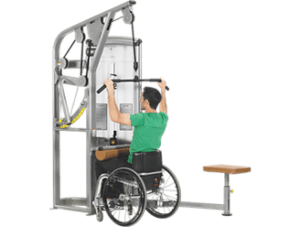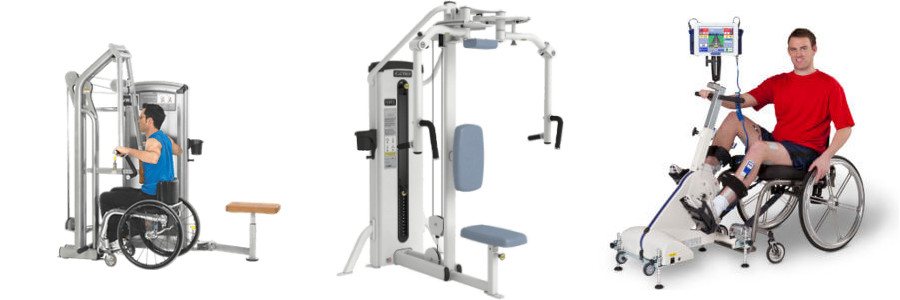The ANTS association inaugurates the S.P.O.R.T. gym (Stimulating People & Organizing Recreational Therapies) on October 12, 2018.
The S.P.O.R.T Gym
Stimulating People and Organizing Recreational Therapies
Regularly maintaining motor activity is recommended by the WHO (World Health Organization) in the CIF (International Classification of Functioning, Disability and Health).
The stimulation of injured limbs through physical activity allows to efficiently fight the risk of secondary complications prone to appear following a spinal injury (Crane 2015).
Accessible muscular reinforcement devices
 Stimulating muscles below the injury allows to manage the cardio-vascular risk by modifying the ratio between lean body mass / fat body mass, and thus premature risks of carbohydrate and lipidic metabolism dysfunctions (Evans 2015). This also allows to reduce thromboembolic risks by repelling venous blood thanks to muscular activity (Rimaud 2008), as well as the risk of fracture of the affected limbs. Physical exercise will stimulate loco-regional vascularization, activating the osteocyte production and improving the dysregulation of bone remodelling (Lai 2010).
Stimulating muscles below the injury allows to manage the cardio-vascular risk by modifying the ratio between lean body mass / fat body mass, and thus premature risks of carbohydrate and lipidic metabolism dysfunctions (Evans 2015). This also allows to reduce thromboembolic risks by repelling venous blood thanks to muscular activity (Rimaud 2008), as well as the risk of fracture of the affected limbs. Physical exercise will stimulate loco-regional vascularization, activating the osteocyte production and improving the dysregulation of bone remodelling (Lai 2010).
Therefore, it allows to maintain physical as well as psychological health for the spinal cord injured, through the improvement of their lifestyle and a renewed self esteem. As a matter of fact, the patient will accept a better body image thanks to the maintenance of muscular volume and contour which make physical appearance more aesthetic.
These physical transformations also ease daily movements (Guiraud 2014), similar to transfers. Physical activity also brings to spinal cord injured a reduction in pain complaints, an improved mood and well-being by preventing disorders such as anxiety, depression and isolation. The activities, individual or grouped, and most often recreational, ease the process of social inclusion. In hospitals, accessible gyms are open to patients to allow them to maintain regular physical activity. This practice is essential to compensate the absence of daily physical activity due to the handicap, as it allows to avoid the appearance of secondary injuries listed above (soreness, cardio-vascular disorders, etc.), as a result of paralysis.
Once out of hospital environments, it is very difficult for people affected by motor handicaps to maintain daily physical activity, as a result of the absence of venues equipped with accessible devices.







